I DO NOT CARE IF WE GO DOWN IN HISTORY AS BARBARIANS: Where Real Horrors Lie In Reinterpretation
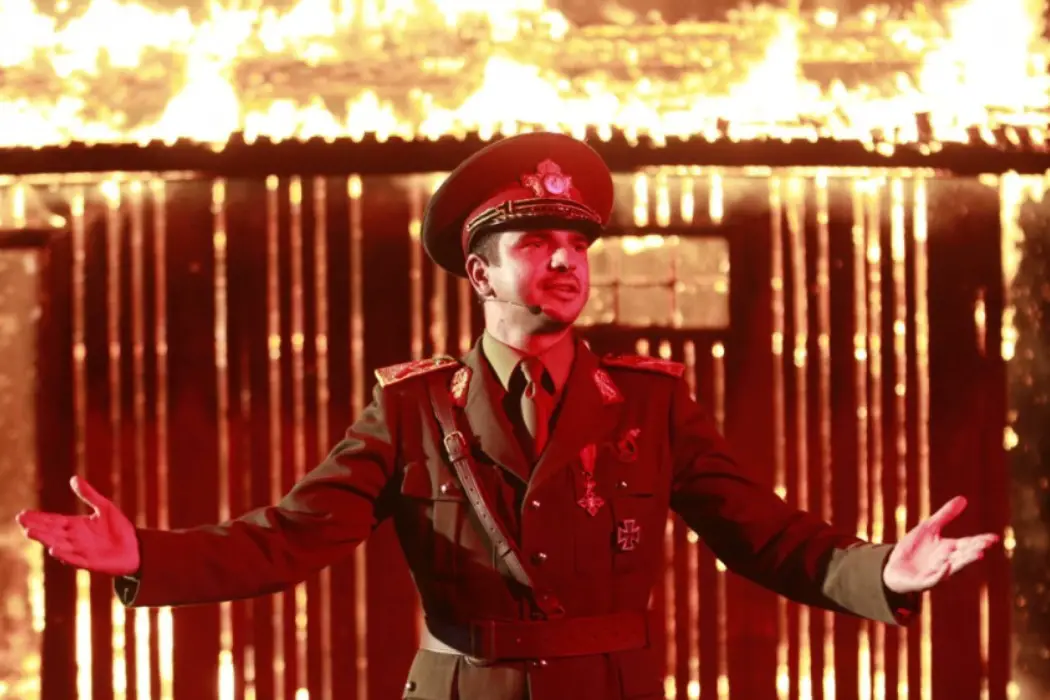
I'm a film journalist and independent filmmaker who fell in…
Even as a deeply personal exploration of Romanian history and society, Radu Jude’s darkly comical satire is as universal as any of our timeless myths and legends, asking us to own up to the toughest of realities and leaving us with results that are, in many ways, absolutely shocking. With a script that never shies away from intellectual discussions and philosophical references, I Do Not Care If We Go Down In History as Barbarians uses the titular quote from Romanian dictator Marshall Ion Antonescu as an opportunity to explore and reassess the varying sentiments of opposing factions in the most hostile of times.
When an ambitious theatre director, Mariana (Ioana Iacob), is given a government-funded opportunity to stage an event from Romanian history, she chooses to focus her efforts on resurrecting the infamous 1941 Odessa massacre, where Antonescu’s troops murdered thousands of Jews. While her team is supportive, she finds a good deal of hostility a great many of her (amateur) actors, who find her ideas to be corruptive and unpatriotic.
At the same time, Movila (Alexandru Dabija), a government official who checks in on the rehearsals, confronts Mariana on her “radical” view on history and threatens to shut down the production unless she is willing to make some sort of “politically correct” compromise. With a crisis of conscience brewing, Mariana struggles to fight off these forces and show that art should never pander and instead always challenge and educate the masses.
Style and Approach
The film breaks the fourth wall within the first ten minutes when we are at the war museum in Bucharest, with Iacob letting us know that she will be playing Mariana, and the film’s slate reveals Jude as director and Marisu Panduru as cinematographer. While Iacob tells us about her character and the film’s cast, she is interrupted with news that some elderly people have arrived to audition for the project. Mariana casually tells us to enjoy the film as she heads over to meet her prospective cast members, with the crew following her as she does.
While the metafictional approach isn’t explicitly present in the remainder of the film’s running time, it proves to be a rather ingenious, thematic touch on behalf of Jude and Panduru, with its overall effect culminating in the third act during the much-hyped reenactment. There is a sense that the filmmakers try to blur the lines between what is real and what is staged, through the use of handheld and static camera movements, and also by switching between digital photography and 16mm film. There is a gritty, handheld approach taken during the scenes inside the war museum and inside the costumes room, as we follow Mariana and her team around, making choices and preparations for their upcoming event, almost alluding to the notion that these are as complicated as the process will get.
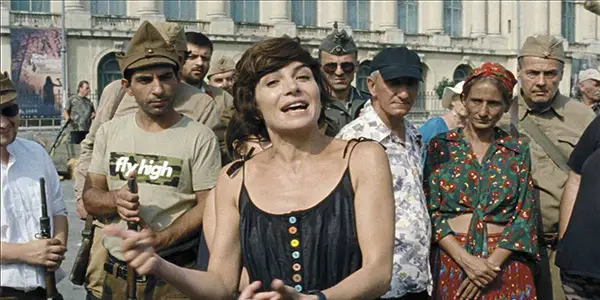
There is a lot of focus on various weapons and life-size figures of costumed infantrymen enclosed in glass cases on display, with Mariana and others interacting with them, taking photos, and occasionally mocking the figures. While this may be a playful attitude that might mock a sense of authority and the political context of the figures, the act is almost mirrored in a twisted irony come the final portion of the film.
When the camera isn’t moving about with great kinetic energy, it stands still on a tripod, and occasionally pans from left to right as it captures scenes in confident long takes. There is a scene when Mariana ventures into one of the museum’s rooms that depicts a battle scene from the perspective of a trench, surrounded by naked trees and a shed. Against the backdrop of a battlefield, soldiers are frozen in time firing at their enemies, with explosions reflected by fierce lighting and sounds. With battlecries heard and the national anthem being chanted, the implication of senseless, violent war seems to become more potent than any documentary footage could exhibit, and Mariana seems to recognise this more than anyone.
Especially because of the hand-held approach initiated in the early scenes of the film, a sense of voyeurism seems to taint the rest of the film, where we are spectres moving about and bearing witness to things that perhaps are better left to be said in private.
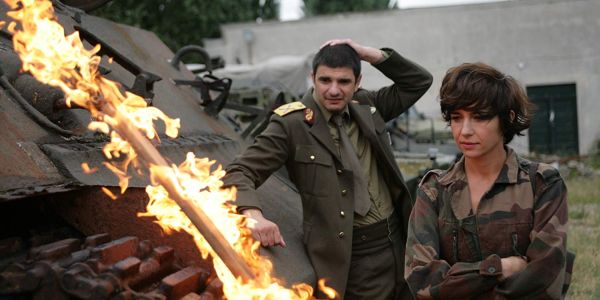
The discussions and rehearsals that take place in the exterior of the museum are similarly minimalist in terms of camera movement, but they happen to be the canvas for which most of the film’s themes are discussed. The choreography of the scenes seem so effortless that they feel improvised, which begs the question as to whether some of the amateur actors were plucked off the streets. When it comes to the combined forces of resentment launched by both Movila and the “actors” against Mariana, the scenes take on a weird carnivalesque form of public forum debates, that seem to be more violent simply through the words uttered rather than through physical force.
There are numerous scenes of Mariana in her apartment with ones that feature her alone as she contemplates the results of the day, sometimes with her lover, Traian (Alex Bogdan), or even when she has her theatre collaborators over having wacky conversations about their country’s history. In fact, much of the film comes down to characters engaging in arguments and strong commentary about Romania’s history of authoritarian-led violence and the sense that people are brainwashed by numerous pieces of wartime propaganda or in dramatisations that mythologise controversial figures like Antonescu, and paint them in a sympathetic light.
One scene where she has people over, is shot in way that almost recalls the maniacal caricatures captured by cinematographer Oleg Mutu in another dark satire, A Gentle Creature (2017), which in its own way suggests a foreboding nature to the depicted conversation.
The actual reenactment scene is shot much like how one would cover any public event from numerous angles, but also showcases the ambition behind Mariana’s artistic vision, and the potential that the theatrical medium has no matter the venue. When the warring armies fire at each other within the open arena that is filled with blue and red mist filters, it is portrayed like a public spectacle with the audience booing and cheering people as though they Roman gladiators or professional wrestlers. The camera flows freely around the arena, deciding what is to be put under the spotlight and what might add up to the film’s overall message.
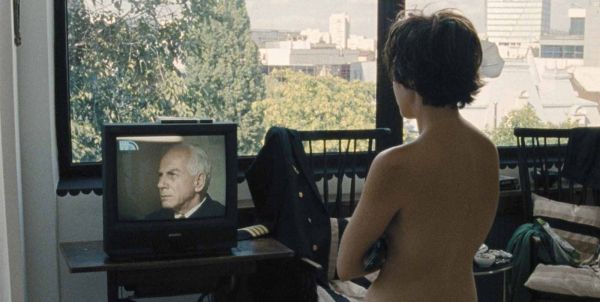
Ultimately, the film’s dramatic scenes and those filled with ideas-filled spectacle are grounded by Iacob’s nuanced performance, as she maintains Mariana’s passion and idealistic nature in private and public, while also showing subtle signs of confusion and defeat. There is also a beautifully naturalistic feel to the acting of the ensemble that flows organically and supports the documentary approach the filmmakers took, which makes it all the more ambiguous as to whether what we are seeing is genuine or scripted.
Themes
Jude doesn’t try to hide the fact that there are numerous sources of inspiration for discussion, and he features novel excerpts read out by Mariana and footage playing on computers and televisions, all of which form various components of the overall discussions that take place in the film. In the first acting, while having a long-distance chat with Traian, Mariana reads the “Crossing the Zbrucz” chapter from Isaac Babel’s Red Cavalry (1926), and just by reading the author’s deliciously poetic use of words, we are able to get a haunting sense of the destruction that the Polish-Soviet War left behind. Her frustrations with her country’s tendency to whitewash history is reflected when a television channel features Sergiu Nicolaescu’s The Mirror (1993), where Antonescu’s trials are played out in a manner that presents him as a hero of martyrdom.
The discussions boast a sense of cine-literacy with the purpose of adding context to the political discussions, and showcase the mentalities of the differing factions. When Movila tries to persuade Mariana to handle the Odessa massacre in a similar fashion to how Steven Spielberg portrayed a German saving Jews in Schindler’s List (1993), Mariana dismisses him by suggesting that Spielberg should make another Jurassic Park film.
Movila represents the entity that prefers to keep citizens in a state of obedience and not to question their country’s authority, fearing protests, riots and uncontrollable anger. All Mariana wants to do is to acknowledge the history of violence that the country cannot shake off, with the intention of highlighting contemporary troubles that also include anti-Semitic feelings. The sense of prejudice that was populated by Adolf Hitler’s hateful Nazi rhetoric spread like a contagion through Europe in the 1930s and 1940s, and to Mariana’s disgust, many of her actors and fellow Romanian citizens are either brainwashed into embracing a blind sense of nationalism, or choose to have selective memory and view their country’s history through rose-tinted glasses. She even makes it clear that Nazi minister of propaganda, Joseph Goebbels, remarked that Antonescu took more extreme measures on the Jews than the Nazi party did.
It’s hard not to see the attitudes of her naysayers as indicative of them being in a state of denial, especially when her arguments are so impassioned and thoughtful in comparison. Of course, Romanian struggles are not the only ones brought up, as Mariana refers to the United States as a problematic nation, with the holocaust of the Native American and their interference in Vietnam and other countries.
Despite Movila’s insistence on ensuring that Mariana remain politically correct with her art and not rattle any cages, there are numerous references to Arabs as Islamists, with casual jokes about Isis beheadings and various insensitive remarks of the like. Movila also makes what could be interpreted as dismissive remarks on the “Darwinism” of various holocausts that time has forgotten (like Herero), all in the purpose of getting Mariana to hold off on tackling the Odessa massacre.
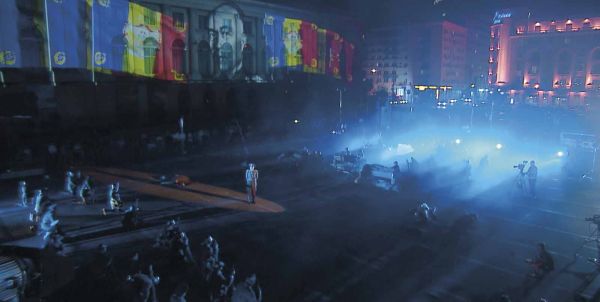
In the beginning Iacob remarks that Mariana is an atheist, and as the film takes off, that simple detail gives her character a whole other dimension. She sees herself as purist when it comes to her artistry and despises the censorship imposed by Movila and the biased, mainstream attitudes that various cast members have adopted. In addition to her appearing to be anti-authoritarian, she is also a proud feminist. It doesn’t help that just about every one of those who challenge her initiative are male, and their attitudes are enabled by Movila.
During the production of the play, she has been likened to dictator Nicolae Ceausecu and Nazi filmmaker Leni Riefenstahl, due to her authoritative hold on her radical vision, while she sees those that defy her as exhibiting that of fascist behaviour.
There is a running side-story where Mariana has private arguments with Traian about her probably being pregnant by him. Traian, who is having an affair with Mariana, worries about him being the father of her baby creating chaos with his own family, and practically threatens her to have an abortion. She tells him to back off and says she doesn’t need his say in the matter as to whether she should bring a child into the world.
It is in those scenes where her struggles are best personified, as she is in a constant battle with patriarchal forces, which only harken back to the various dictators who left behind numerous scarred reminders throughout history. Those that try to soften her art, are, in her eyes, no different than fascist regimes trying to erase evidence of their crimes and anything that threatens their image.
Impasse
While it is clear that Jude is taking Mariana’s side, there is a strong sense of “devil’s advocate” at play where he is almost a spectre of a third party as he examines the conflict between Mariana and her opposing forces. It almost seems to say that neither side is truly right in this matter, and that the arguments are pointless.
Consider the film’s use of various pieces of wartime propaganda that celebrate Romania’s efforts in the Second World War, which are interspersed with raw footage and photographs of the various victims of Antonescu’s rule. What Jude does is have the camera hold on the photos that feature corpses, or on footage of victims being buried in an insignificant manner, as Mariana and others discuss the aesthetics of the play, or various political ideas. She even laughs around with the sound designer as they listen to screaming voices of those affected by violence and war.
Despite her good intentions, even Mariana proves that it is hard for people who have never experienced was as either a soldier or a victim to understand the devastating consequences and lasting torment. What is exhibited, is serious desensitisation where imagery of the deceased can’t get our respect and sympathy. Both she and the worried government officials may overestimate the power her artistic statement may have over the individual, who perhaps may not be able to recognise the ethics and humanity behind her work but only the spectacle.
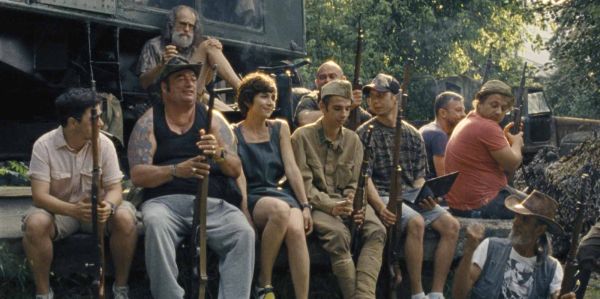
There are also rather amusing discussions as to how innocent many Romanian soldiers (under Antonescu) appear to be, and how the the SS officers seem more sexually enticing as opposed to the Romanian soldiers. What these attitudes suggest is that underneath the emblems and uniforms are ordinary men and women who are only conditioned to behave and think a certain way by ruling entities. But the ruling entities are like in the hydra in Greek Mythology; cut off one head, and many more will take its place. And the screams of the dead are forever lost in the silence of man’s ignorance.
I Do Not Care If We Go Down In History as Barbarians: Conclusion
I Do Not Care If We Go Down In History as Barbarians makes a bold statement about power and violence without resorting to fighting fire with fire. It is a layered, masterful work that proves that artistic mediums carry tremendous weight, and that what audiences bring to them will determine exactly how much they will take away.
What did you think of the film? What would you have done if you were in Mariana’s shoes? Let us know in the comments below!
I Do Not Care If We Go Down In History as Barbarians will be released in the United States on July 19th, 2019.
https://www.youtube.com/watch?v=5VJSRtrhdTg
Does content like this matter to you?
Become a Member and support film journalism. Unlock access to all of Film Inquiry`s great articles. Join a community of like-minded readers who are passionate about cinema - get access to our private members Network, give back to independent filmmakers, and more.
I'm a film journalist and independent filmmaker who fell in love with cinema at a young age. I also love writing about comics, literature, podcasts, television and video games. I'm just as content watching a movie about a giant killer pig terrorising the Australian outback as I am with one that features a catholic priest in crisis.













